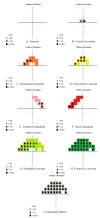The SCHEIE Visual Field Grading System
- PMID: 28932621
- PMCID: PMC5602567
- DOI: 10.4172/2155-9570.1000651
The SCHEIE Visual Field Grading System
Abstract
Objective: No method of grading visual field (VF) defects has been widely accepted throughout the glaucoma community. The SCHEIE (Systematic Classification of Humphrey visual fields-Easy Interpretation and Evaluation) grading system for glaucomatous visual fields was created to convey qualitative and quantitative information regarding visual field defects in an objective, reproducible, and easily applicable manner for research purposes.
Methods: The SCHEIE grading system is composed of a qualitative and quantitative score. The qualitative score consists of designation in one or more of the following categories: normal, central scotoma, paracentral scotoma, paracentral crescent, temporal quadrant, nasal quadrant, peripheral arcuate defect, expansive arcuate, or altitudinal defect. The quantitative component incorporates the Humphrey visual field index (VFI), location of visual defects for superior and inferior hemifields, and blind spot involvement. Accuracy and speed at grading using the qualitative and quantitative components was calculated for non-physician graders.
Results: Graders had a median accuracy of 96.67% for their qualitative scores and a median accuracy of 98.75% for their quantitative scores. Graders took a mean of 56 seconds per visual field to assign a qualitative score and 20 seconds per visual field to assign a quantitative score.
Conclusion: The SCHEIE grading system is a reproducible tool that combines qualitative and quantitative measurements to grade glaucomatous visual field defects. The system aims to standardize clinical staging and to make specific visual field defects more easily identifiable. Specific patterns of visual field loss may also be associated with genetic variants in future genetic analysis.
Keywords: Glaucoma; Glaucomatous visual fields; Open-angle glaucoma; Standard automated perimetry; Visual field defects; Visual field grading; Visual fields.
Figures



References
-
- Weinreb RN, Khaw PT. Primary open-angle glaucoma. Lancet. 2004;363:1711–1720. - PubMed
Grants and funding
LinkOut - more resources
Full Text Sources
Other Literature Sources
Molecular Biology Databases
